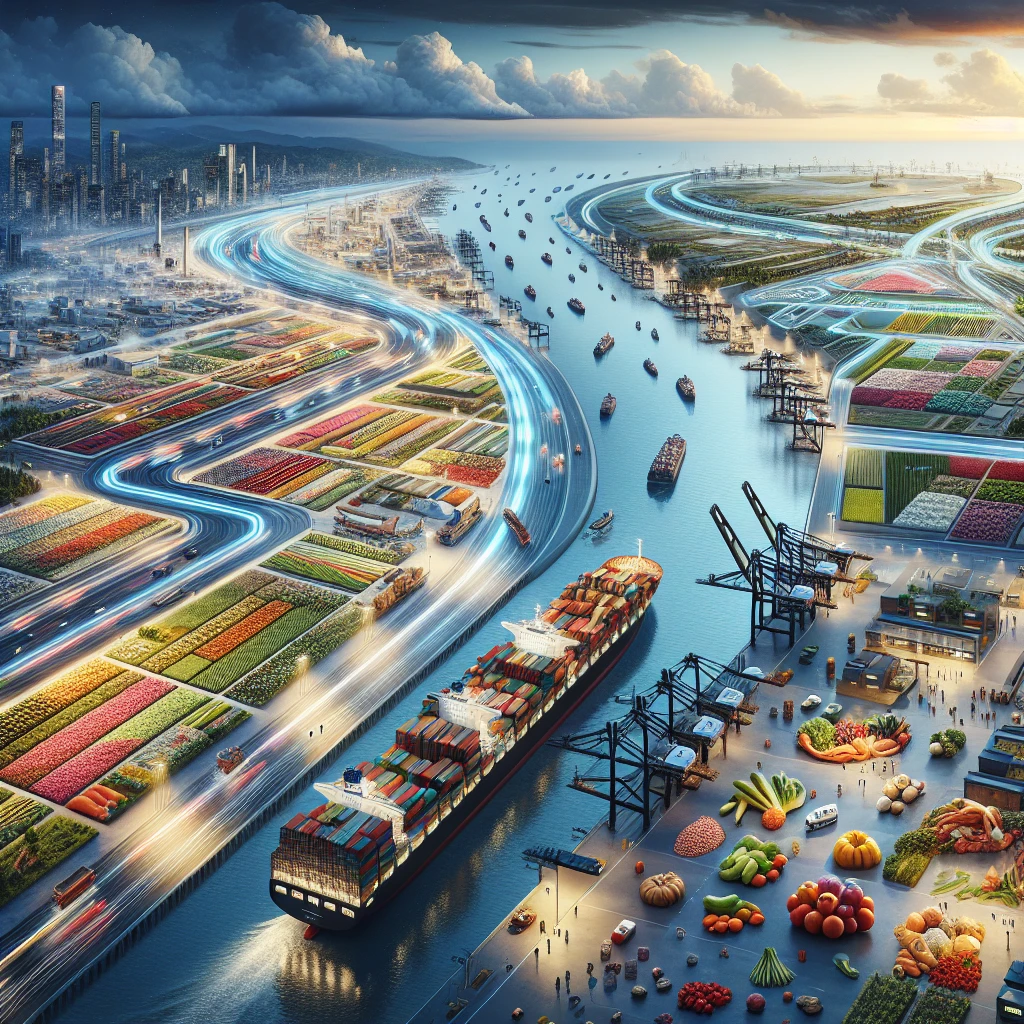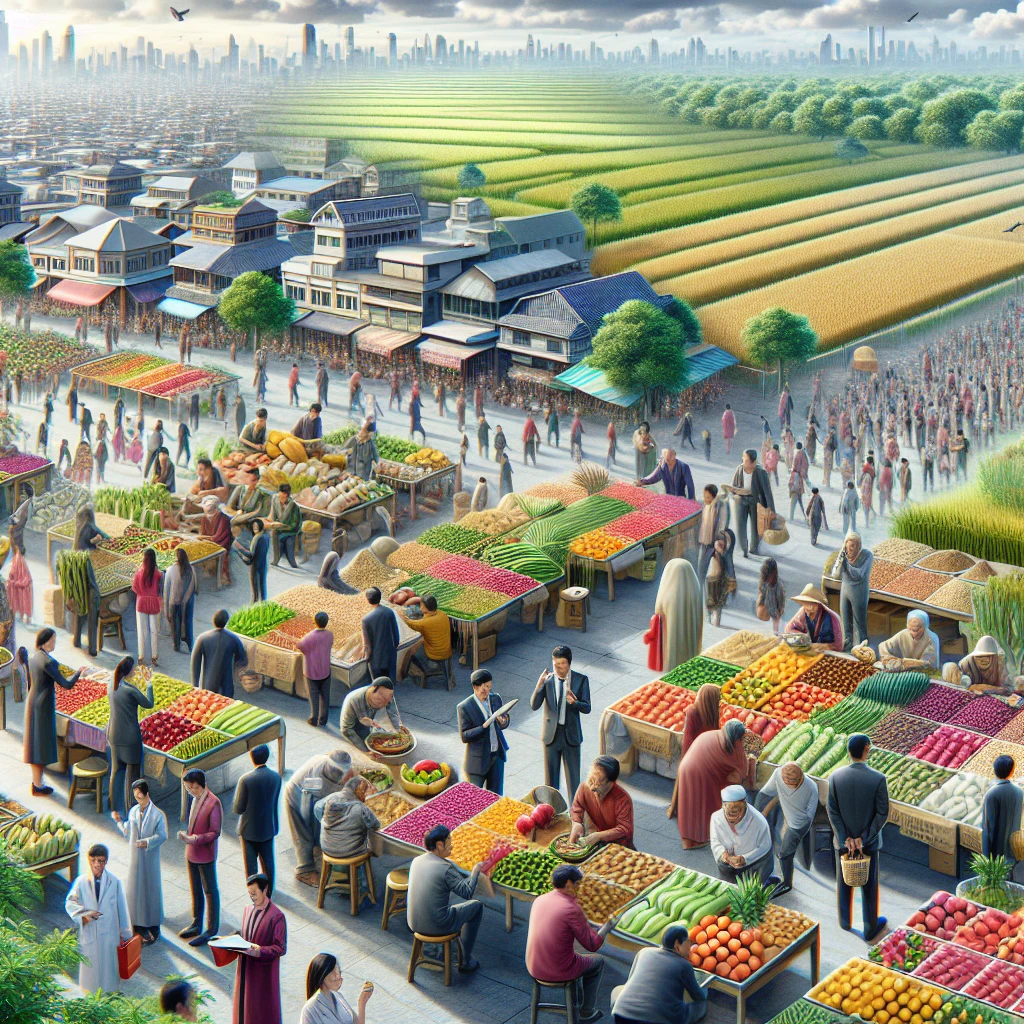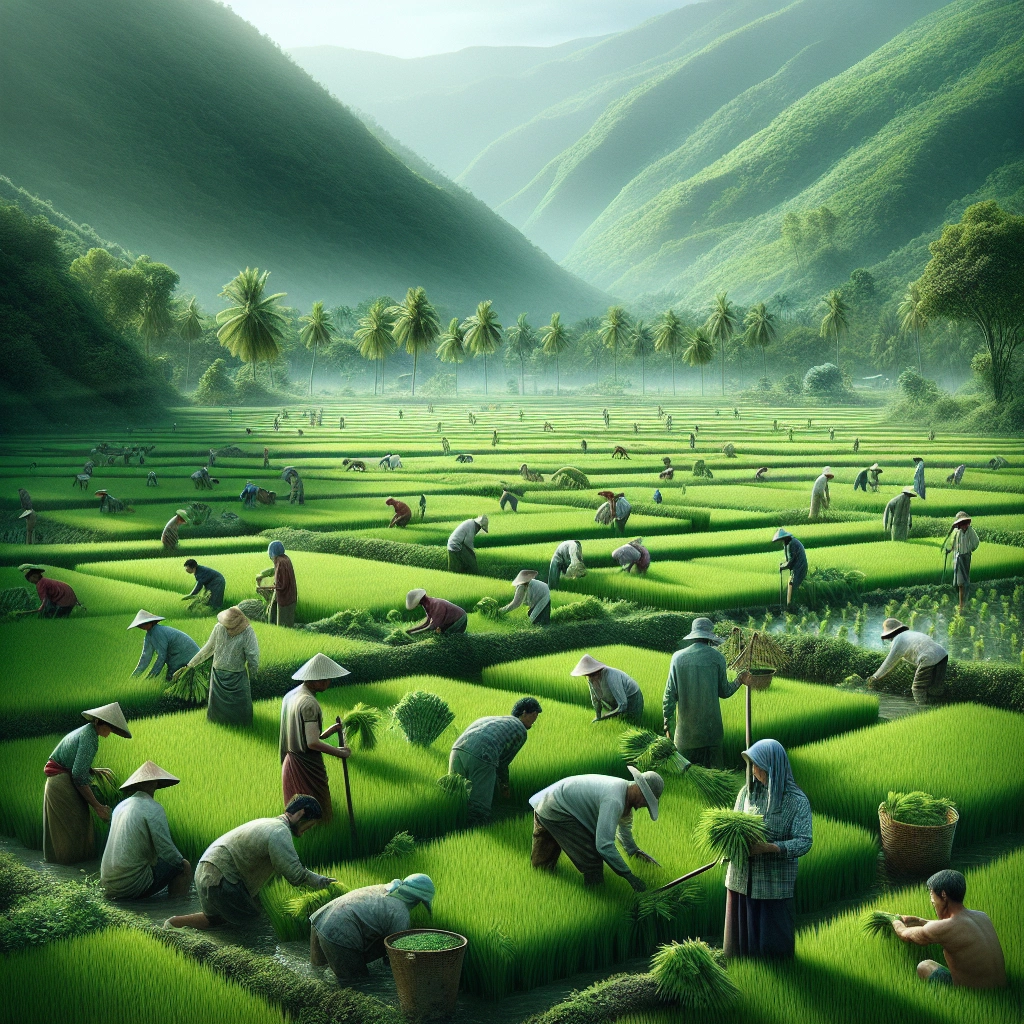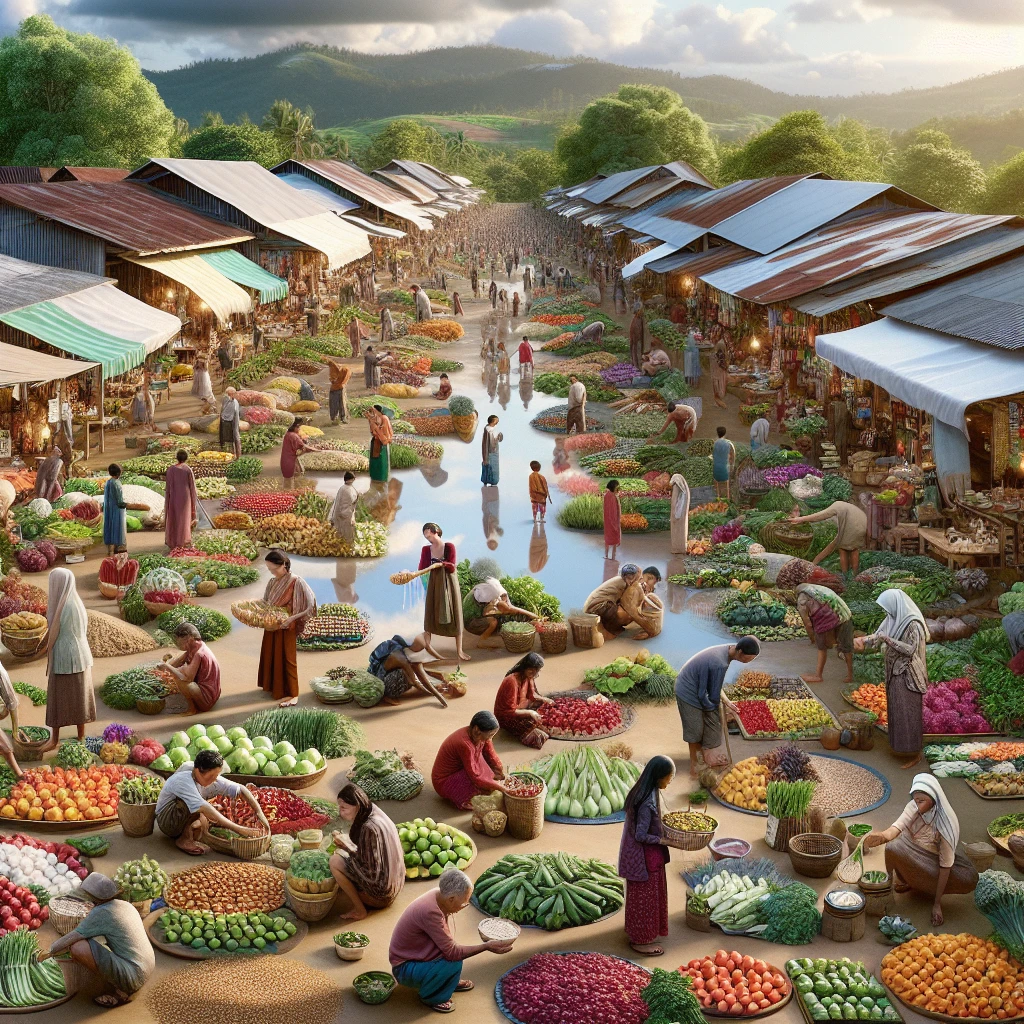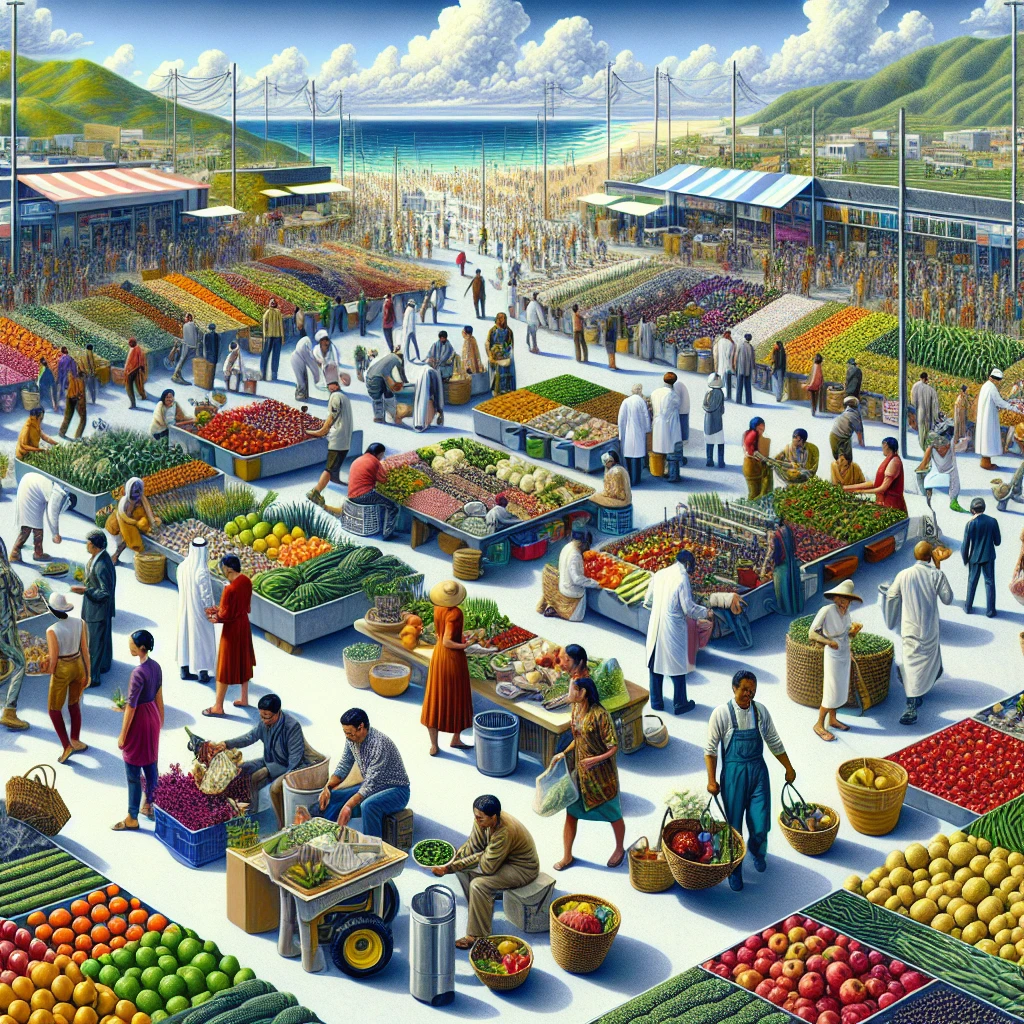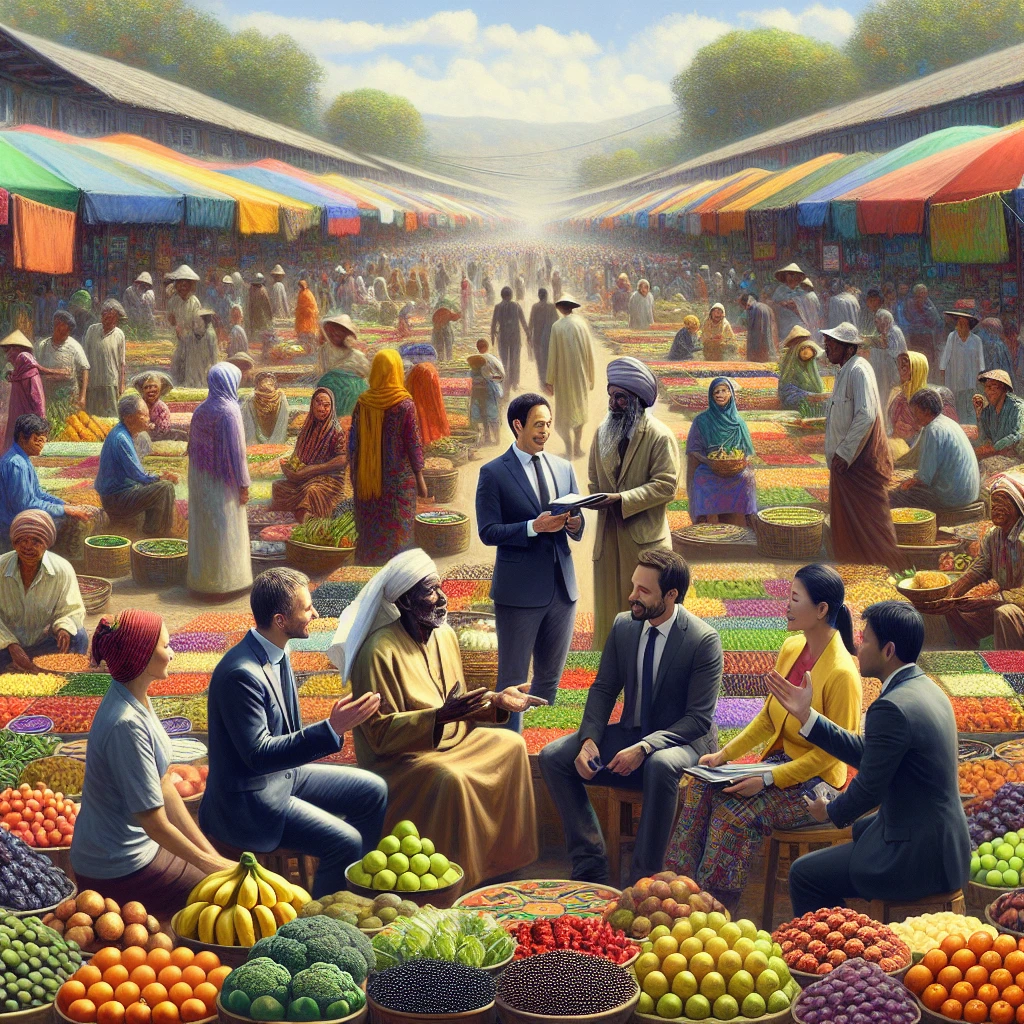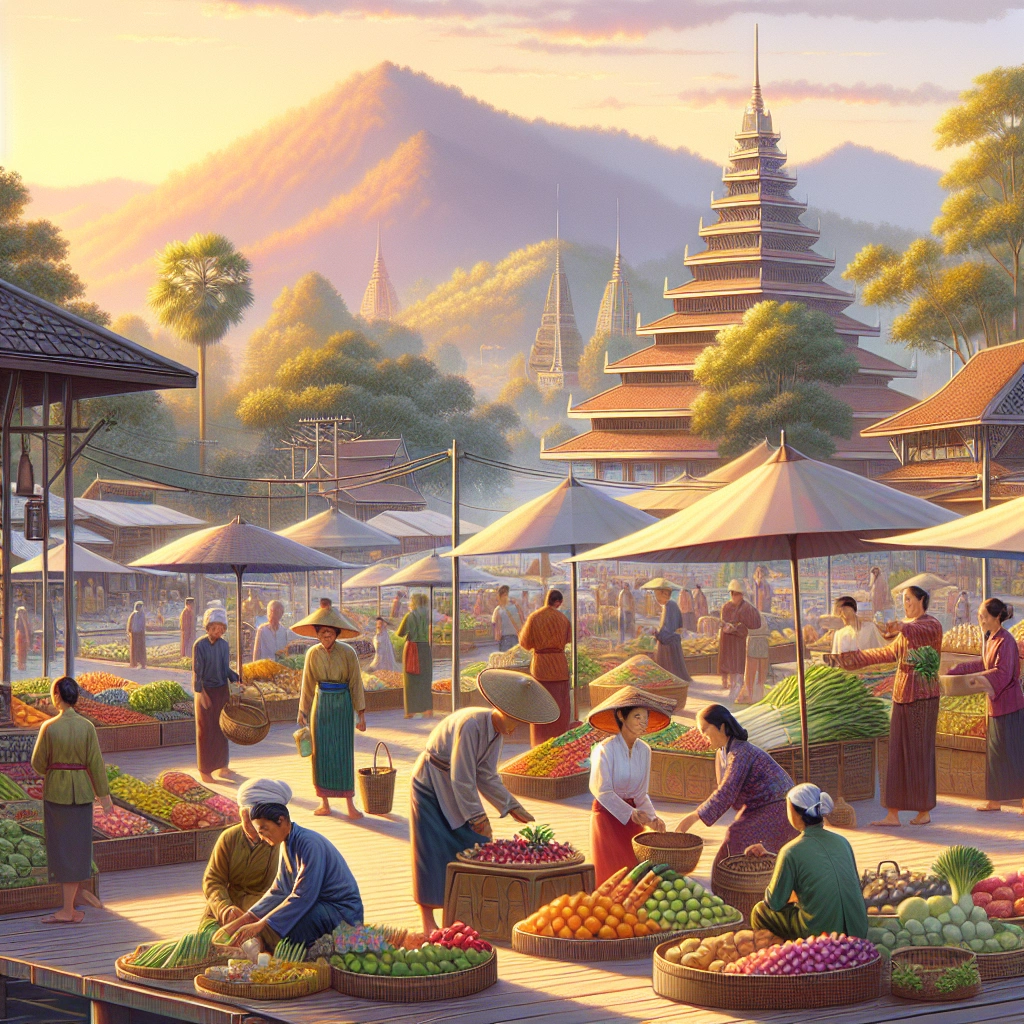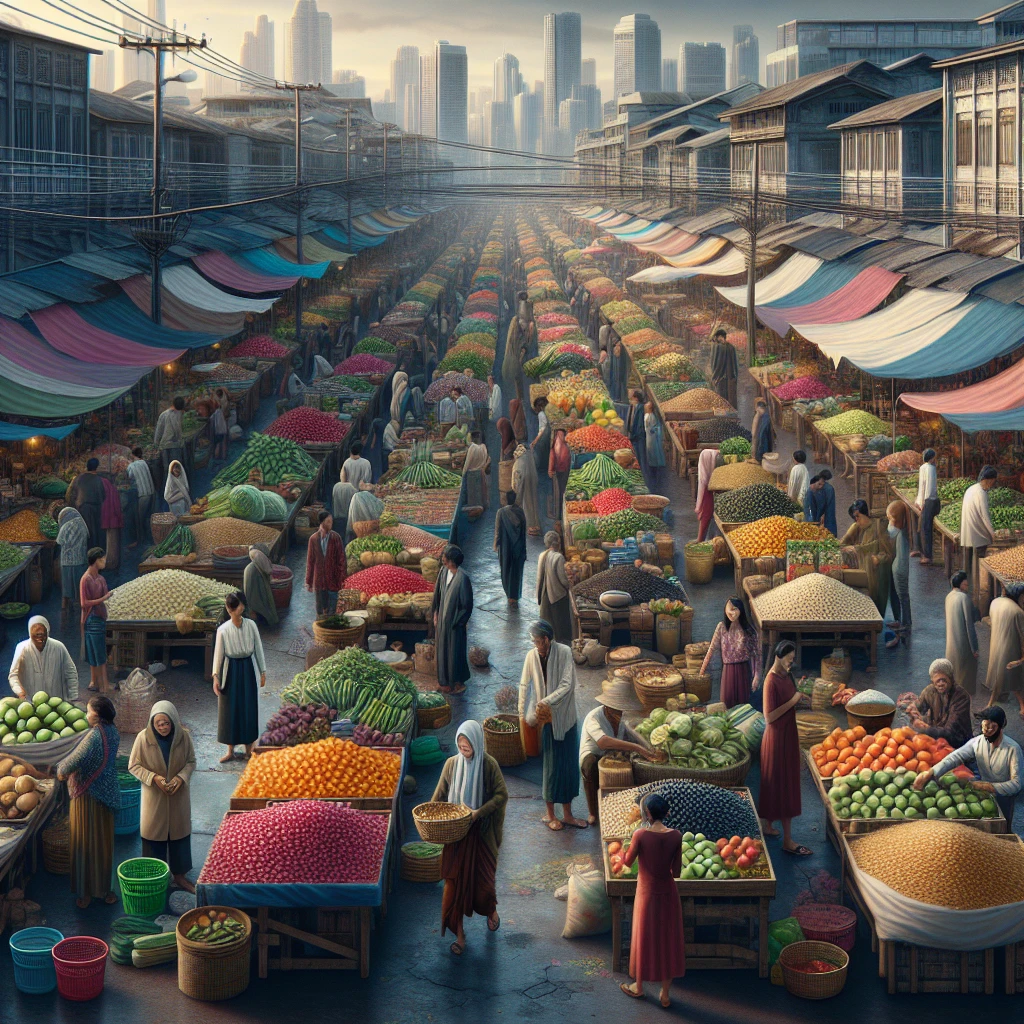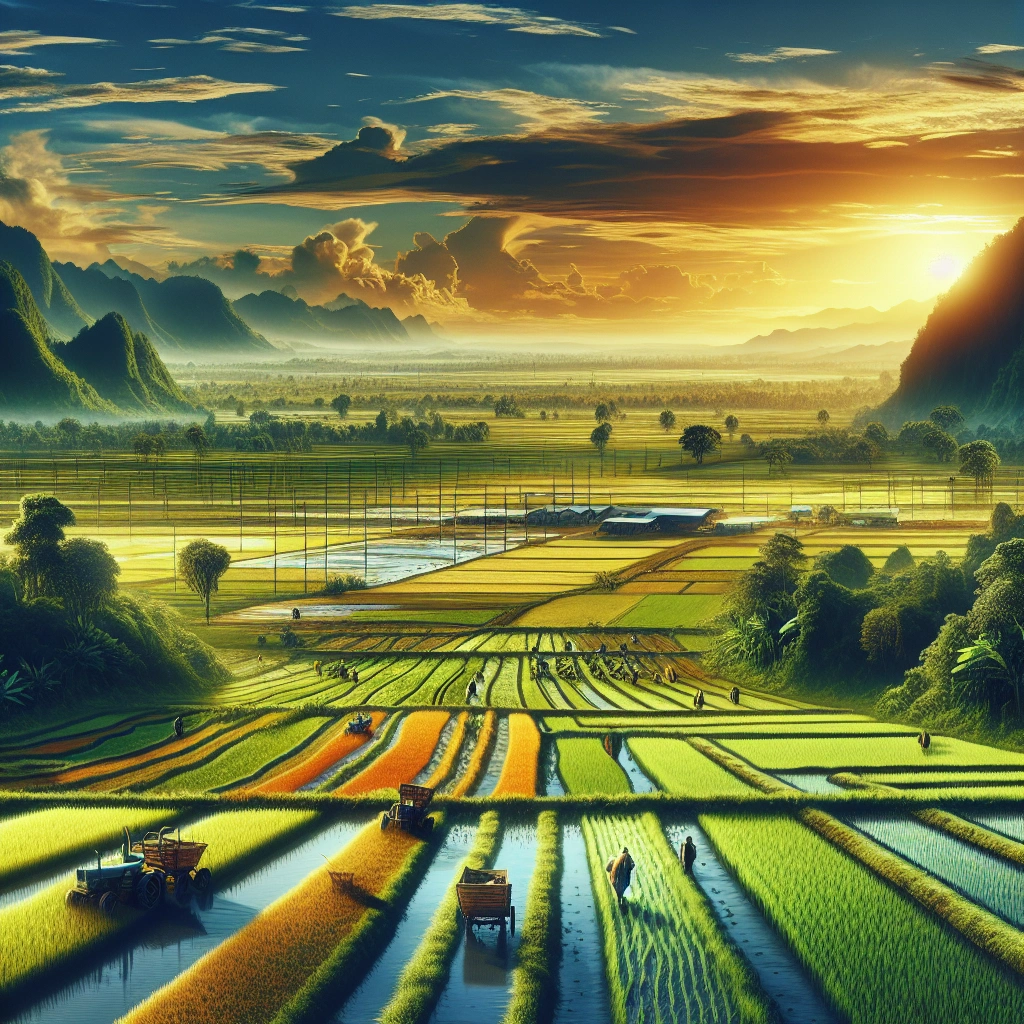

Food security in Asia is a critical concern due to slowing gains in agricultural productivity, overexploitation of natural resources, and increasing water scarcity. These issues are compounded by strong income and population growth, industrialization, and urbanization in the region, which continue to drive fundamental structural changes in global food supply.
As Asia becomes more urban and prosperous, food prices are at risk of rising unless supply can keep pace with demand.
The Association of Southeast Asian Nations (ASEAN) region is facing progress, challenges, and future prospects in addressing food security. With nearly 1.1 billion people in the region lacking healthy diets due to poverty, addressing the food crisis is crucial.
The Asian Development Bank (ADB) has committed to providing significant support and loans to promote sustainable food security in Asia and the Pacific.
Moreover, the Food Security Roadmap Towards 2030 addresses the need for open collaboration and action to ensure food security in the region. With climate change and biodiversity loss impacting food systems, there is an urgency to improve long-term food security.
The current state of food security and nutrition in Asia and the Pacific tells a grim story, with an estimated 375.8 million people facing hunger in 2020.
Check out this Youtube video: “Land Matters: Unlocking Asia’s Food Security Issue | Part 1/3” to gain valuable insights and knowledge about the pressing issue of food security in Asia.
Challenges to Food Security in Asia
Climate change and its impact on food production
Agricultural production in Asian countries is under severe threat due to the impact of climate change. The region has witnessed extreme weather patterns such as droughts, heat waves, erratic and intense rainfall, storms, floods, and emerging insect pests, all of which have significantly affected the livelihood of farmers.
This has led to a decrease in crop yields, making it harder to ensure food security for the population. For example, in India, rising temperatures and changing rainfall patterns have affected crop production, leading to decreased food availability for the growing population.
Rapid population growth and urbanization
The rapid population growth and urbanization in Asia have transformed food systems in numerous ways, increasing the demand for diverse products, including more high-value and processed products. Urbanization plays a pivotal role in shifting patterns of food supply and demand, thereby influencing food security.
As the pace of urbanization accelerates in Asia-Pacific, food security and nutrition in urban areas will be determinant in achieving the Sustainable Development Goal. For instance, more than half of the Asian population is projected to reside in urban centers by 2020, leading to a surge in the demand for food and essential resources, thereby affecting food security in the region.
Access to clean water for agriculture
Access to clean water for agriculture remains a significant challenge in Asia and the Pacific, with an estimated 500 million people lacking basic water supply and 1.14 billion people lacking access to sanitation. Water scarcity in the region casts a dark cloud over food security as groundwater resources are over-abstracted and contaminated, while erratic rainfall patterns further hinder agricultural activities.
This scarcity of clean water directly impacts agricultural production, limiting crop yields and hindering the overall food security in the region.
| Country | Lack of Water Supply (in millions) | Lack of Sanitation Access (in millions) |
|---|---|---|
| India | 108 | 522 |
| China | 175 | 270 |
| Philippines | 13 | 11 |
| Indonesia | 78 | 82 |
| Bangladesh | 42 | 65 |
Asia’s Dependence on Imports
Reliance on imported food and its impact on food security
Asia’s heavy reliance on imported food products has raised concerns about the region’s food security. With over 80% of consumers purchasing imported goods, there is a significant impact on domestic food production and self-sustainability.
The increased dependence on imports exposes Asia to potential supply chain disruptions, affecting the availability of essential food items and posing a threat to food security.
Vulnerability to supply chain disruptions
Asia’s vulnerability to supply chain disruptions has become increasingly apparent, leading to challenges in ensuring a consistent and reliable food supply. Factors such as natural catastrophes, cyber attacks, and infrastructure issues have contributed to disruptions in the region’s supply chains.
This vulnerability poses a risk to food security, as it creates uncertainty in the availability of imported food products, impacting everyday consumption and overall nutrition.
| Country | Food Import Dependence |
|---|---|
| United States | $133 billion USD |
| China | $105.26 billion USD |
| Germany | $98.90 billion USD |
| Japan | $68.86 billion USD |
| United Kingdom | $66.54 billion USD |
| Netherlands | $64.38 billion USD |
| France | $62.29 billion USD |
Asia’s heavy reliance on imported food products has significant implications for food security, especially considering the vulnerability to supply chain disruptions. The region must address these challenges by enhancing domestic food production and adopting measures to minimize the impact of global market fluctuations on food security.
Innovations in Agriculture
Use of technology for sustainable farming practices
Sustainable farming practices have been revolutionized by the use of innovative technology such as precision agriculture. This technology allows farmers to make near real-time observations, measurements, and responses, resulting in more efficient and sustainable farming methods.
For example, sensor technologies enable the monitoring of various aspects of agriculture, including aerial imagery, cattle movement, and micro-climate data collection, leading to more precise and environmentally friendly farming practices.
Adoption of climate-resilient crops
The adoption of climate-resilient crops is crucial for ensuring food security, especially in regions prone to extreme weather conditions. Farmers are increasingly embracing early-maturing cereal crop varieties, heat-tolerant varieties, and drought-tolerant legumes to mitigate the impact of climate change on agriculture.
For instance, the utilization of resilient crops like drought-tolerant corn has proven effective in enhancing climate resilience and ensuring consistent crop yields in the face of challenging environmental conditions.
| Sustainable Farming Technologies | Climate-Resilient Crops |
|---|---|
| Precision agriculture | Early-maturing cereal crop varieties |
| Sensor technologies | Heat-tolerant crop varieties |
| Digital agricultural solutions | Drought-tolerant legumes |
The combined use of technology for sustainable farming practices and the adoption of climate-resilient crops represents a significant step toward addressing the challenges of food security in the context of Asia and beyond.
Improving Infrastructure for Distribution
Improving transportation to ensure food reaches remote areas
Efficient transportation is crucial to ensure the timely delivery of food to remote areas, addressing food scarcity and reducing dependency on imports. Upgrading road networks and investing in reliable transportation systems can significantly enhance the accessibility of essential food supplies to underserved regions, thereby strengthening overall food security.
Building storage facilities to reduce food waste
Investing in modern storage facilities, including cold storage systems, is imperative to reduce food waste. Cold storage technology can prolong the shelf life of perishable food items, mitigating potential spoilage and losses.
Furthermore, adequate storage infrastructure helps ensure the availability of fresh produce in the market, contributing to improved food security and sustainability.
| Transportation Solutions | Storage Facility Innovations |
|---|---|
| Upgrading road networks | Implementing cold storage |
| Reliable transportation systems | Modern storage facilities |
| Enhancing food accessibility | Prolonging shelf life of perishable items |
| Strengthening local food systems | Mitigating potential spoilage and losses |
By focusing on transportation improvements and storage facility upgrades, we can bolster food security and combat the challenges associated with food scarcity and wastage in diverse regions.
Government Policies and Food Security
Implementing policies to ensure a stable food supply
To ensure a stable food supply in Asia, governments can implement policies focused on agriculture, infrastructure, and trade. These policies should prioritize investments in agricultural technology, irrigation systems, and transportation networks to enhance food production, distribution, and accessibility. By supporting local farmers with subsidies, training, and access to markets, governments can boost domestic food production and reduce reliance on imports. Additionally, promoting sustainable farming practices and crop diversity can mitigate the impacts of climate change on food availability.
Addressing trade barriers for easier and more affordable food imports
Addressing trade barriers is crucial for easier and more affordable food imports in Asia. Governments can negotiate trade agreements to reduce tariffs, quotas, and other restrictions that hinder the import of essential food products. Streamlining customs procedures and standardizing regulations can also facilitate smoother and cost-effective food trade. Moreover, collaboration with international organizations and neighboring countries can foster regional cooperation for efficient food supply chains and emergency provisions.
| Challenges | Solutions |
|---|---|
| Tariffs and quotas | Negotiate trade deals to reduce import restrictions and tariffs |
| Custom procedures | Streamline customs processes and harmonize trade regulations |
| Regional collaboration | Foster partnerships for regional food security and emergency response |
Empowering Local Farmers
Small-scale farmers play a crucial role in providing affordable, fresh, and nutritious food to their communities. However, they often encounter challenges such as limited resources, inadequate infrastructure, and gender biases that hinder their success.
To empower these farmers, it is essential to provide them with education and resources. For instance, offering training in good agricultural practices and business management skills can greatly enhance their ability to manage their land effectively and cultivate crops efficiently.
Supporting small-scale farmers through education and resources
Additionally, organizations like Opportunity International focus on training farmers to improve their farming techniques and practices, further enhancing their productivity. Moreover, the USDA is developing tools to aid small and mid-sized farmers in making sound financial decisions, which is critical in ensuring their long-term success and sustainability.
Implementing fair trade practices for agricultural products
Implementing fair trade practices is also vital in empowering local farmers. Through fair trade programs, small-scale farmers can receive fair compensation for their products, ensuring that they can sustain their livelihoods.
The Fair Trade Practices Program, comprising divisions such as Food Disclosure and Labeling and Perishable Agricultural Commodities Act, plays a crucial role in promoting fair trade and protecting the interests of farmers dealing with fresh and frozen produce.
| Comparison | Supporting Through Education and Resources | Fair Trade Practices |
|---|---|---|
| Objective | Enhancing farmers’ skills and farming practices | Ensuring fair compensation for farmers |
| Examples | Training in good agricultural practices and business management | Fair compensation for agricultural products |
| Impact | Improved productivity and sustainability | Sustained livelihoods for farmers |
By supporting small-scale farmers through education and resources, and implementing fair trade practices for agricultural products, we can create a more equitable and sustainable agricultural industry, ultimately contributing to improved food security in Asia.
Add education and resources are critical. Providing training in good agricultural practices and business management skills enhances productivity and sustainability.
The implementation of fair trade practices ensures fair compensation for farmers, contributing to sustained livelihoods and a more equitable agricultural industry.
Promoting Sustainable Farming
Encouraging organic and regenerative farming practices
Promoting sustainable farming involves advocating for organic and regenerative farming practices, which offer numerous benefits. Regenerative agriculture, for instance, enhances soil health, fertility, and moisture retention, leading to healthier crops and improved yields.
This method focuses on holistic farming systems, improving water and air quality while enhancing ecosystem resilience. Embracing organic farming practices contributes to a healthier environment and supports the long-term sustainability of agriculture.
Reducing the use of harmful pesticides and fertilizers
Furthermore, promoting sustainable farming includes reducing the use of harmful pesticides and fertilizers, which have adverse impacts on both the environment and human health. Excessive and inefficient use of fertilizers leads to nutrient losses and environmental degradation.
Similarly, pesticides have been linked to serious effects on human health, including cancer and neurological disorders. By minimizing the use of these harmful chemicals, sustainable farming helps to protect ecosystems, safeguard biodiversity, and ensure the well-being of farming communities.
| Benefits of Regenerative Farming | Impact of Pesticides and Fertilizers |
|---|---|
| Enhanced soil health and fertility | Adverse effects on the environment and human health |
| Improved moisture retention | Link to serious health issues such as cancer and neurological disorders |
| Holistic farming systems | Excessive and inefficient use leading to nutrient losses |
| Ecosystem resilience | Necessity to minimize use for environmental protection |
Prioritizing organic and regenerative farming practices, as well as reducing the use of harmful pesticides and fertilizers, is vital for promoting sustainable agriculture and ensuring a secure food supply for the future.
Remember, sustainable farming is the key to a thriving and resilient agricultural sector. Let’s embrace these practices for a greener, healthier, and more bountiful tomorrow!
Reducing Food Waste
To implement practices that reduce food waste at all levels of the supply chain, it is crucial to measure the types and amounts of wasted food to identify areas for improvement. Additionally, staff training in temperature management, product handling, and stock rotation is essential.
Embracing less-than-perfect looking produce and educating customers on effective food management, such as meal planning and storage techniques, can significantly minimize wastage.
Creating awareness about the impact of food waste on food security is paramount for sustainable change. Consumers should be educated about the consequences of food wastage on global food security and the environment.
By implementing preservation techniques, reconsidering expiry labels, and promoting public education campaigns like Save The Food, we can collectively reduce food waste and its adverse effects on food security globally.
| Strategies to Reduce Food Waste | Details |
|---|---|
| Measure wasted food amounts and types | Identify areas for reduction |
| Staff training in temperature and product management | Improve handling and storage |
| Embrace less-than-perfect produce | Reduce discarding based on appearance |
| Consumer education on effective food management | Promote better meal planning and storage techniques |
Strengthening Food Resilience
Diversifying food sources to reduce dependence on specific crops is crucial for enhancing food resilience. By promoting agroecological diversification, we optimize biomass and water harvesting, leading to increased productivity and resource-use efficiency.
This approach not only creates new market opportunities but also strengthens ecological and socio-economic resilience. As studies suggest, crop diversification improves agricultural production, enhances availability, and contributes to sustainable food systems.
Establishing food reserves for emergency situations is equally vital in ensuring food security. Governments maintain the strong view that adequate emergency food reserves can buffer national food price shocks.
By developing a two-week emergency supply and maintaining emergency food reserves, we can protect vulnerable populations and stabilize food prices during disasters. It’s essential to be prepared for emergencies such as floods, fires, and natural disasters to maintain food safety and availability.
| Diversifying Food Sources | Establishing Food Reserves |
|---|---|
| – Optimizes biomass and water harvesting | – Helps buffer national food price shocks |
| – Increases productivity and resource-use efficiency | – Protects vulnerable populations |
| – Creates new market opportunities | – Stabilizes food prices during disasters |
Investing in Research and Development
Supporting the development of new crop varieties suited for changing climates is vital in ensuring food security, especially in regions like Asia. By investing in research and development for climate-resilient crop varieties, we can address the challenges posed by climate change and ensure sustainable food production.
Cutting-edge advancements in crop breeding techniques, such as genetic modification and precision breeding, can lead to the creation of crops that are better adapted to extreme weather conditions, thus bolstering food security in Asia and beyond.
Furthermore, funding research for innovative food production methods is crucial for enhancing agricultural productivity and efficiency. Investing in cutting-edge technologies such as precision agriculture, hydroponics, and vertical farming can revolutionize food production and enable countries to meet the growing demand for food in Asia.
These innovative methods not only improve crop yields but also reduce resource usage, making them essential for sustainable food security in the region.
| Climate-Resilient Crop Varieties | Innovative Food Production Methods |
|---|---|
| – Drought-tolerant crop varieties | – Precision agriculture for higher yields |
| – Heat-resistant crop varieties | – Hydroponics for efficient resource usage |
| – Flood-tolerant crop varieties | – Vertical farming for urban food production |
Investing in research and development for new crop varieties adaptable to changing climates and innovative food production methods is pivotal for mitigating food security challenges in Asia. These efforts will play a crucial role in ensuring a sustainable and secure food supply for the rapidly growing population in the region.
Collaboration with International Organizations
Working with international organizations for food aid and support is crucial for addressing food security challenges in Asia. Partnering with entities like Feed the Future and the International Food Relief Partnership (IFRP) allows for the provision of life-saving food assistance to vulnerable populations across the region.
This collaboration helps in reducing hunger and malnutrition, ensuring that people have access to adequate, safe, and nutritious food for healthy and productive lives.
Participating in global initiatives for sustainable food security reinforces the commitment to addressing long-term food challenges in Asia. Collaborations with the World Food Programme (WFP) and other non-governmental organizations (NGOs) allow for a concerted effort to contribute to all four pillars of food security – availability, access, utilization, and stability.
By working collaboratively with various partners, including governments, private sectors, and academia, the focus on sustainable food and agriculture initiatives can be strengthened to benefit the region.
| International Organizations | Key Initiatives |
|---|---|
| Feed the Future | Provides life-saving food assistance and supports sustainable food security programs. |
| International Food Relief Partnership (IFRP) | Expands capabilities of non-profit organizations for managing international food aid programs. |
| World Food Programme (WFP) | Works collaboratively with over 1,000 NGOs to bring much-needed food assistance to vulnerable populations worldwide. |
| U. S. Government Global Food Security Strategy 2022-2026 | Aims to end global hunger, poverty, and malnutrition by pursuing an integrated whole-of-government approach. |
Collaboration with international organizations strengthens the efforts to address food security challenges in Asia, providing crucial support and participating in global initiatives for sustainable food security.
Public Awareness and Education
Educating the public about the importance of sustainable food practices
As we look to the future of food security in Asia, it is crucial to educate the public about the significance of sustainable food practices. Sustainable farming methods, such as precision agriculture and organic farming, play a pivotal role in ensuring a consistent food supply while minimizing environmental impact.
By promoting these practices through educational campaigns and workshops, we can empower farmers and consumers alike to make informed choices that promote the long-term health and sustainability of our food systems.
Encouraging consumer choices that support food security
Consumer choices have a significant impact on the direction of our food and agriculture systems. By raising awareness about the connection between individual dietary choices and food security, we can encourage consumers to support sustainable food production.
Highlighting the benefits of locally sourced, seasonal produce and emphasizing the importance of reducing food waste can empower consumers to make choices that contribute to the resilience and stability of our food supply.
| Sustainable Food Practices | Consumer Choices |
|---|---|
| Precision agriculture leveraging technology for efficient food production | Choosing locally sourced, seasonal produce |
| Organic farming methods for minimal environmental impact | Reducing food waste through mindful consumption |
| Educational campaigns and workshops for farmers and consumers | Awareness of the connection between personal dietary choices and food security |
Let’s work together to raise awareness and educate individuals about the crucial role of sustainable food practices in ensuring food security for Asia and beyond. By empowering both farmers and consumers, we can create a more resilient and sustainable food system for the future.
Remember, a great man once said, “The choices we make today will impact the food security of tomorrow.” Let’s make those choices count!
Adapting to Changing Consumer Trends
As we witness an increased interest in healthier foods and the rise of plant-based diets, the impact on food security cannot be understated. The shift in consumer preferences towards sustainable and locally sourced food options has the potential to significantly impact the global food system.
These changes necessitate a reevaluation of supply chains and agricultural practices to ensure food security for all, especially in regions vulnerable to food shortages.
Addressing the impact of changing consumer preferences on food security
The changing consumer preferences towards healthier, sustainable, and locally sourced foods pose both challenges and opportunities for food security. While it may lead to greater demand for organic and sustainable farming practices, it also requires adaptation to fulfill the growing need for these products in a way that maintains food security globally.
Promoting sustainable and locally sourced food options
Promoting sustainable and locally sourced food options aligns with the shift in consumer trends and can contribute to addressing food security challenges. By supporting local farmers and businesses, communities can boost economic growth, foster community resilience, and reduce their environmental footprint.
Additionally, embracing sustainable agricultural practices can protect the biodiversity of the land and contribute to environmental conservation efforts.
Comparison Impact of Changing Consumer Preferences
| Impact | Implications |
|---|---|
| Healthier Foods | Demand for organic and sustainable farming |
| Plant-Based Diets | Shift towards alternative protein sources |
| Locally Sourced Food | Economic growth and community resilience |
Adapting to changing consumer trends involves understanding the evolving preferences for healthier, sustainable, and locally sourced food options. As we navigate these shifts, it is essential to consider their impact on food security and implement strategies that promote a more sustainable and secure global food system.
Addressing Food Security During Crises
Developing contingency plans for food security during natural disasters:
In the event of natural disasters, such as earthquakes or floods, developing robust contingency plans for food security becomes crucial to mitigate the impact on vulnerable populations. These plans should encompass efficient logistics for food distribution, establish emergency food reserves, and ensure the availability of clean water for consumption and sanitation.
For instance, countries in prone-to-disaster regions like Asia can create strategic stockpiles of essential food supplies, partnering with international relief organizations to swiftly mobilize aid in times of crises.
Ensuring access to food during times of crisis:
During crises, ensuring access to food demands a coordinated effort between local governments, international aid organizations, and non-governmental entities. Implementing measures such as price control on essential food items, providing meal distribution centers, and establishing safe community kitchens helps in preventing food shortages and ensuring access to nutritious food for affected populations.
For example, countries in Asia with a history of typhoons can collaborate with local suppliers and farmers to establish a steady supply chain for food essentials, enabling the continuous provision of food to affected areas even during disasters.
| Pros | Cons |
|---|---|
| Efficient logistics for food distribution | Dependence on donor aid |
| Price control on essential food items | Supply chain disruptions |
| Establishing safe community kitchens | Administrative challenges in coordination |
These initiatives are fundamental in safeguarding food security during crises, especially in disaster-prone regions such as Asia, where proactive measures are essential to ensure access to food in times of calamity.
Monitoring and Evaluation
Implementing systems to monitor and evaluate the effectiveness of food security measures
Implementing robust monitoring and evaluation (M&E) systems is crucial to ensuring the effectiveness of food security measures in Asia. By establishing clear metrics and data collection processes, we can track the impact of interventions, such as nutritional programs and agricultural initiatives, on food availability and accessibility for vulnerable populations.
Making adjustments based on feedback and data analysis
Upon analyzing the M&E data, it is imperative to make timely adjustments to existing food security measures. For instance, if the data indicates a lack of access to essential nutrients in certain regions, immediate interventions such as fortified food distribution or agricultural training programs can be implemented to address the identified gaps.
| M&E Benefits | M&E Challenges |
|---|---|
| Enables evidence-based decision-making | Data collection logistics |
| Identifies areas of improvement | Resource constraints |
| Facilitates program accountability | Ensuring data accuracy |
| Guides resource allocation | Complex data interpretation |
However, the implementation of these M&E systems may pose challenges, such as efficient data collection logistics and ensuring data accuracy. Addressing these challenges is essential to harnessing the full potential of M&E in enhancing food security across Asia.
Recommended Amazon Products for Ensuring Food Security in Asia
Here’s a curated list of products that can help improve food security in Asia. These recommendations are based on functionality, price, and reviews.
Water Irrigation System


A water irrigation system can help farmers efficiently water their crops, leading to improved agricultural productivity. It provides consistent water supply to plants, ensuring better yield and food sustainability.
Solar-Powered Refrigerator


Solar-powered refrigerators are essential for storing perishable food items in areas with unreliable electricity supply. This technology helps reduce food waste and ensures a steady food supply, especially in remote areas.
Hydroponic Growing Kit


Hydroponic growing kits allow farmers to grow crops without soil, using water and nutrient solutions. This method promotes sustainable farming practices and can be implemented in areas with poor soil quality.
Weather-resistant Seeds


Weather-resistant seeds are specifically bred to withstand the impact of climate change on food production. These seeds can help farmers adapt to changing weather patterns and ensure consistent crop yields.
Mobile Storage Silo


A mobile storage silo provides a flexible and portable solution for storing grains and other food items. It enhances food distribution and reduces the risk of food spoilage, particularly in remote or underserved areas.
| Product | Pros | Cons |
|---|---|---|
| Water Irrigation System | Consistent water supply for crops, Improved agricultural productivity | Initial installation cost |
| Solar-Powered Refrigerator | Reduced food waste, Reliable food storage | Higher upfront investment |
| Hydroponic Growing Kit | Sustainable farming, Suitable for areas with poor soil quality | Requires technical knowledge |
| Weather-resistant Seeds | Adaptation to climate change, Consistent crop yields | Higher seed costs |
| Mobile Storage Silo | Portable storage solution, Reduced food spoilage | Limited storage capacity |
Top Recommended Product for Ensuring Food Security in Asia
If you’re looking for the best solution to improve food security in Asia, we highly recommend the Hydroponic Growing Kit. This kit allows for sustainable farming practices and is suitable for areas with poor soil quality. Ready to improve food security? Check out the Hydroponic Growing Kit today for the best results!


Conclusion
To achieve sustainable food security in Asia, key steps such as investing in agricultural research and technology, promoting sustainable farming practices, and improving infrastructure and distribution networks are crucial. By addressing local and regional challenges, Asia can enhance its food production capacity and ensure a stable food supply for its growing population.
Collaborative efforts play a vital role in addressing the challenges of food security in Asia. Cooperation among governments, non-governmental organizations, and the private sector is essential in promoting knowledge sharing, resource pooling, and effective policy implementation.
Through collective action, the region can better tackle issues such as climate change, food wastage, and economic disparities, ultimately leading to a more secure and resilient food system in Asia.
The pursuit of sustainable food security in Asia requires a multifaceted and coordinated approach. By implementing the key steps mentioned and fostering collaborative efforts, the region can work towards ensuring that all its inhabitants have access to safe, nutritious, and affordable food, thus contributing to the overall well-being and development of the continent.



